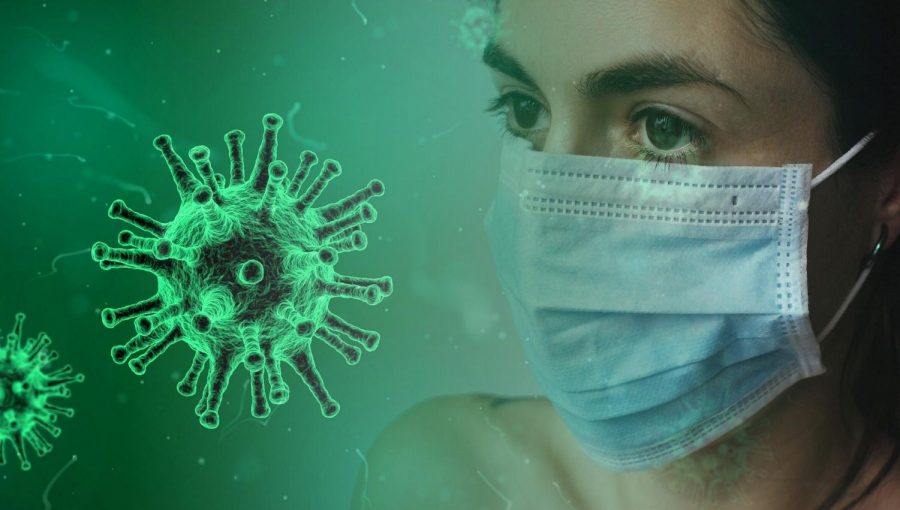The Infamous Coronavirus
March 27, 2020
**Statistics in this article are subject to change, as the situation of COVID-19 is constantly changing
By now we’ve all heard of the infamous coronavirus. Having originated in China, it’s now spread to over 90 countries. According to the CDC, there are many forms of the virus. The one that is currently going around is called COVID-19 (coronavirus disease 2019). Coronaviruses are mainly found in animals, like bats and cattle, but rarely spreads to humans.
According to the CDC, if you are older or have pre-existing health conditions, you have a higher chance of catching the virus. If you catch COVID-19 and are healthy, then symptoms could appear similar to the common cold. What’s scary about it is how fast it’s spreading and there is no known cure for it. Hospitals are not prepared for the massive amounts of people who will be sick during the pandemic. The problem is there simply aren’t enough respirators for everyone. In some countries, doctors are having to decide who lives and who dies.
Many countries are taking precautions of the virus and doing their best to contain it so it doesn’t spread more. That means mass quarantine. Just recently, Italy has come under a nationwide quarantine. China is also on quarantine where the virus is bad. “I think China’s measures have been extreme but have also made a lot of progress, and that the US should have more strict rules in place as well,” said Katherine Harron ’21 when asked if what some of the countries are doing to prevent the virus is smart. If anyone travels to a country that is a high risk for the virus, then the CDC recommends you cough/sneeze into a tissue or your elbow, and then immediately wash your hands with soap and water for at least 20 seconds. Another option is to use a hand sanitizer that has at least 60% alcohol.
When returning from a country, the CDC says symptoms appear 2-14 days after getting exposed to the disease. Some symptoms are fever, shortness of breath, or a cough. If you experience any of those symptoms when returning from a country that has an outbreak of COVID-19, call your doctor and avoid coming in contact with people.
To take personal caution, some people are washing their hands and using hand sanitizer more often. Grace Morrison ’22 commented, “Yes, my whole family will carry hand sanitizer and bacteria-killing wipes. Last time we flew we wore masks, but masks are a better choice for people who already have the virus.” According to the CDC, the virus spreads from person to person. In other words, it means close contact with people, typically through respiratory droplets, like coughing or sneezing. Because of this, being in confined places with a lot of other people is very risky. Doctors are telling people to remain 6 feet apart if they have to go out.
With more outbreaks spreading fastly and quickly, some people are canceling their vacations so they don’t get sick. Traveling to countries that have the virus is high risk. In particular, the US government recommends not traveling by cruise ship. Because of how close you are with people on a cruise ship, the virus can spread more easily and faster. Many people are canceling their cruise vacations so they don’t become sick and spread the disease. Even if you are not at high risk of contracting the coronavirus, it is still dangerous to become a carrier for the illness and possibly infect those who are more at risk or overwhelm the hospitals.
Many people aren’t letting a virus stop their spring break plans. Whether an airline stops flights or if the place they are going to is not safe, many people are still going. Airlines now have flights that don’t cost very much. Many people, especially young adults, are using cheap flights to travel places. Round trip flights to some places in the United States could be less than $200 per person. WFS school nurse Emily Green is still planning on traveling. Green commented, “I have plans to travel to San Diego, and the only reason I would not go is if they cancel my flight.” Katrina Winfield ’20 is “still going to Florida” as her family originally planned.
Just recently, Governor John Carney declared COVID-19 a public health emergency and announced a stay-at-home order for citizens in Delaware. All non-essential businesses in Delaware until May 15, or until further notice. According to Delaware Online, people can only leave their homes for work if their job is still permitted to stay open, medical care, shopping for groceries, and exercising using social distancing. Non-essential places are closed. That includes car dealerships, clothing stores, performing art companies, and schools. To this effect, WFS is currently holding classes online. Fortunately, restaurants in Delaware are offering take-out and delivery. Carney said one of the important reasons why the order took place was because people weren’t taking social distancing seriously and he wants Delaware to be an example of what to do in a crisis.
For now, the virus will continue to spread without a cure. On March 11, WHO declared the coronavirus a pandemic. Though the flu has currently killed more people, we are just at the beginning of a global outbreak and thousands more are predicted to die in the months to come. All signs currently point to the pandemic getting worse. Hopefully, the virus will eventually slow down from people/countries quarantining themselves, but for now, all we can do is be safe. Remember to wash your hands, and to cough and sneeze into a tissue or elbow to prevent passing on the disease.































